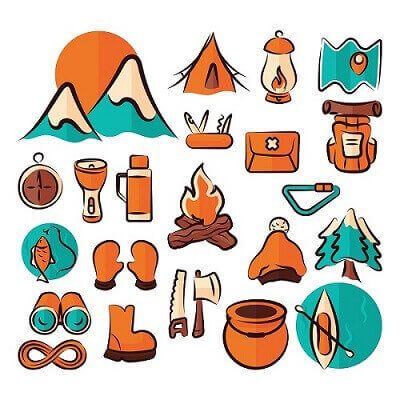This is a list of the key items of equipment you should have with you every time you go into the wild for a day trip. Of course, you can take more with you but this minimum day trip packing list will be enough to keep you safe.
Essential Day Trip Packing List
 1. Map and compass
1. Map and compass
A GPS is optional and a good idea if you have it but make sure that you have a traditional compass as back up and that all members of the party know how to use it.
2. Walking boots
If you are going out into the wild you must have the proper shoes.
Trainers or fashion shoes will not be sturdy enough to support your ankles or cushion your feet from the impact of hard walking.
Do not be tempted to take new boots out on a long walk, make sure that they are properly broken in before your trip otherwise you will end up suffering from blisters.
3. Socks
You should wear properly designed walking socks; these cushions your feet in the right places and will help reduce blisters.
4. Rucksack
This should be large enough to carry everything you need but not so large that you are uncomfortable. You will take a smaller sack on a day trip compared with a week in Yellowstone!
Regardless of the length of your trip or the size of your rucksack, you should ensure that it is properly fitted to your back (most are adjustable) and comes with comfortable, padded hip support and chest straps.
5. Waterproof clothing
Even if rain is not forecast on your trip you should make sure that you are able to keep dry if necessary.
6. Spare clothing
This is a must for even the shortest trips. If you get wet you will get cold, if you get cold you are at danger of hypothermia so it is important to have a spare, dry, change of clothes.
Pack a hat and gloves as well to keep your extremities warm or your head shaded from the sun.
7. First aid kit
You don’t need to pack the whole ER supply closet but it makes sense to have a supply of sterile dressings, antiseptic wipes, bandages, sting relief cream, etc., just in case.
8. Sun cream and insect repellent
The sun can be strong, even on cool and hazy days, so always protect your skin.
When you walk you sweat and sweat attracts flies which are annoying and other insects that may give dangerous or painful bites. Insect repellent helps to keep them away.
9. Water system
Whether you choose to carry your water in bottles or in a hydration bladder you should make sure that you have plenty with you.
Make sure that you also have some means of purifying water if you need to refill when you are out.
10. Cooking supplies
Unless you are only going to be out for an hour or two you should take a small stove, cooking pan, plate, mug and camping ‘spork’ (spoon and fork combined) with some high energy quick food (instant noodles, hot chocolate, malt drinks, etc).
If you will not be out for long enough to need a stove to remember to take a means to start a fire so that you can signal for help, if necessary.
11. Knife
You don’t need a full-on Crocodile Dundee blade but you should carry a sturdy blade that can be used to gut fish or rabbits if necessary.
12. Flashlight and batteries
Even if you are not planning to be out after dark it is possible that you might be delayed or that fog or bad weather will render a flashlight useful.
Always pack spare batteries; you don’t want to get your flashlight out only to find that it has gone dead just when you need it.
13. Survival sack or bivvy bag
If you are delayed or get lost you may need to keep yourself warm overnight.
A survival sack is a high visibility bag that is designed to give you a little more insulation than your clothes alone and will keep you safe in an emergency.
A bivvy bag is a step up, a cross between a survival sack and a small sleeping bag/tent.
Extra Equipment for Longer Trips
If you are heading out into the wilderness for more than a day you will need to pack some extra equipment.

1. Tent
How big a tent you pack is up to you.
You might decide to pack a single tent for your whole group and split the constituent parts when carrying it.
Alternatively, you might decide to each pack a small, light, one-man tent.
2. Sleeping bag
Sleeping bags are available in a bewildering array of weights and tog ratings (for warmth).
These are generally described in shops as ‘seasons’ with a 1 season bag being suitable for summer only and a 4 season bag being a suitable year-round.
Even in the height of summer, it can get very cold in some areas, particularly in the mountains. In some areas, the weather can change without notice.
You should aim for your bag to be comfortable in at least 10 degrees colder than the average night time ‘low’ temperature for the area you plan to be in.
As a rule of thumb, a 3 season bag should be fine for summer and late spring, early fall camping but a 4 season bag is advisable at all other times.
3. Sleeping mat
Your sleeping mat insulates you from the cold of the ground which can leach the heat out of your system. It also helps to keep you comfortable.
There are two types available, foam mats and inflatable mats. Generally speaking, the inflatable mats, though more expensive, are lighter and better.
4. Toilet paper and spade
You get the idea!
Day Trip Clothing
 Your clothing is one of your most important safety items. It helps to protect you from the elements including both extreme heat and extreme cold.
Your clothing is one of your most important safety items. It helps to protect you from the elements including both extreme heat and extreme cold.
One of the most vital things, when surviving in the wild, is to maintain your core body temperature.
The human body should be kept at a temperature between 96 and 102 Fahrenheit. Overheating and hypothermia are two of the most dangerous obstacles that can be faced by a person out in the wild.
The key to good clothing for the wild is to dress in (and pack) multiple layers, each layer traps a small amount of air and helps to insulate the body, a number of thin layers are more efficient than one thick one.
A good base layer will wick sweat away from your body preventing chafing and excessive cooling. In the winter you will need long johns and a long-sleeved T. In the summer a vest top and shorts will be sufficient, although consider packing a longer set for the night time.
Over the base layer, you should wear a thicker fleece layer (in winter) or lighter top and trousers in the summer. Your final layer should be wind and waterproof. Many companies sell jackets that can have a fleece layer zipped into the waterproof shell making them easy and comfortable to wear.
Where possible makes sure that your middle and outer layer is made from breathable, wicking materials that will allow moisture to escape. A Gore-Tex jacket is ideal for this purpose. You should never leave home without a hat, a warm heat in the winter and a sun hat in the summer.
Gloves and a scarf (a lighter, cotton one in the summer) are also necessary to keep you warm. If you are planning on walking in the snow or during a wet period you should consider wearing gaiters over your boots, this will prevent water or snow from getting inside the boot.
When you are walking, even in the coldest weather, your body will sweat and you will get hot. If you find yourself getting a warm try, at first, to loosen off elastics or vents at your neck, wrists, and ankles to increase airflow.
If this does not help cool you down remove one layer but place it in an accessible place in your pack so that you can put it on again if you need to.
When you stop, make sure that you put it on again as you can get cold very quickly once you are no longer generating heat from exercise. In the summer it can be tempting to walk in shorts.
In some areas, this can be very pleasant but in others you should think about wearing long pants, even on the warmest days, to protect from insect dangers. You will know if you are walking in such a place.
Some clothing companies sell pants that can be transformed into shorts by zipping off at the knees; these can be a good compromise.

Leave a Reply